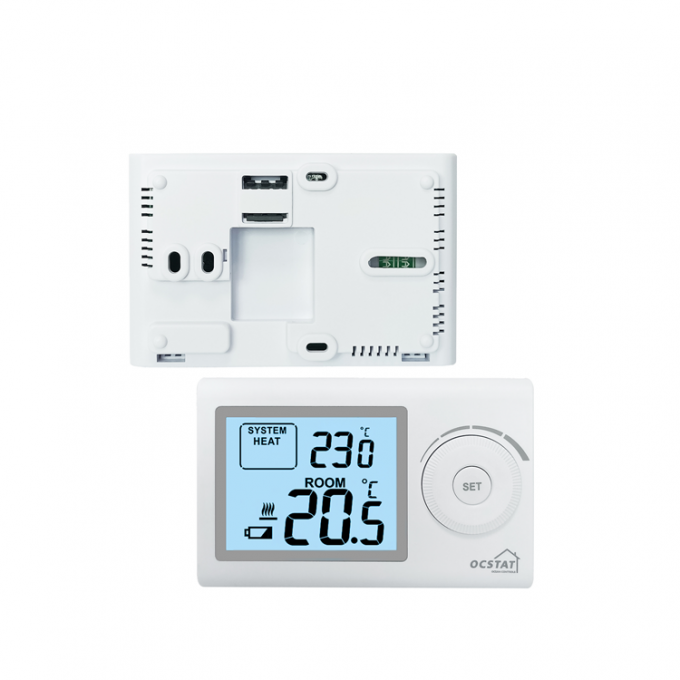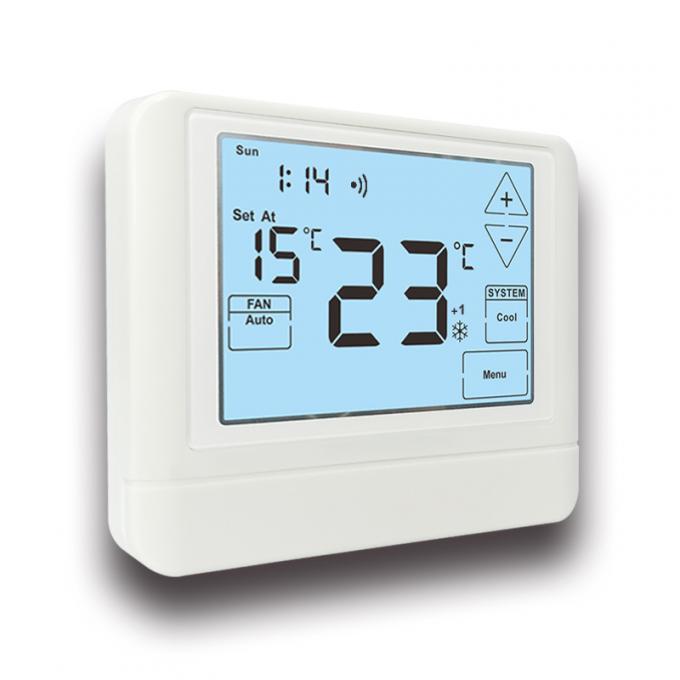Digital Thermostat with Remote Sensors: Achieving Whole-Home Temperature Balance with Precision
Traditional digital
thermostats rely on a single built-in sensor, which means they only measure the temperature of the room where they’re mounted—leaving other spaces too hot, too cold, or ignored entirely. The
Digital Thermostat with Remote Sensors solves this critical flaw by pairing a central
thermostat with wireless sensors placed in key rooms, ensuring every area of your home stays comfortable. In this blog, we’ll explore how these thermostats work, their key benefits, and why Ocean Controls Limited’s offerings—available at
www.riseem.cn—are a top choice for homeowners seeking balanced, efficient heating and cooling.
A
Digital Thermostat with Remote Sensors is an advanced temperature control system that combines a central digital
thermostat (for main control and display) with one or more wireless remote sensors (placed in other rooms). Unlike standard digital thermostats, which only use their built-in sensor to regulate HVAC systems, this setup collects temperature data from multiple locations. The central
thermostat then uses this aggregated data to adjust heating or cooling—either averaging the temperatures across all sensors, prioritizing a specific room (e.g., the bedroom at night), or responding to the coldest/warmest spot. Most models also let you view real-time temperatures from each sensor via the thermostat’s digital display or a companion app, giving you full visibility into your home’s climate.
How Remote Sensors Enhance Digital Thermostat Performance
The magic of this system lies in how remote sensors address the “hot/cold spot” problem that plagues traditional thermostats. Here’s a breakdown of their key role:
- Multi-Zone Temperature Monitoring: Remote sensors (typically battery-powered and wireless) are placed in rooms like bedrooms, living areas, or home offices—spaces where you spend the most time. They send temperature data to the central thermostat every few minutes.
- Smart Temperature Regulation: The central thermostat uses pre-set rules to act on this data. For example:
-
- Average Mode: It calculates the average temperature across all sensors and adjusts HVAC to maintain that average.
-
- Priority Mode: It focuses on the temperature of a specific sensor (e.g., “prioritize bedroom sensor from 10 PM–6 AM”).
-
- Balance Mode: It targets the coldest sensor in winter (to warm all rooms evenly) or the warmest sensor in summer (to cool consistently).
- Eliminating Guesswork: With real-time sensor data on the digital display, you no longer have to “guess” if the bedroom is warm enough or the living room is too cool—you can see exact temperatures at a glance.
Ocean Controls Limited’s sensors use RF (radio frequency) or Wi-Fi for reliable data transmission, ensuring no lag or dropped signals even in large homes.
Key Benefits of a Digital Thermostat with Remote Sensors
1. Consistent Whole-Home Comfort
The biggest advantage is eliminating hot and cold spots. A traditional
thermostat in the hallway might read 72°F, but the bedroom (with no sunlight) could be 68°F, and the kitchen (near the oven) could be 76°F. Remote sensors let the
thermostat adjust HVAC to fix these inconsistencies, ensuring every room you use stays within your comfort range (usually ±1°F).
2. Energy Savings Without Sacrifice
By focusing on the rooms you actually use (not just the hallway where the thermostat is mounted), you avoid wasting energy heating or cooling empty spaces. For example:
- If the guest room is unoccupied, the thermostat can ignore its sensor and prioritize the living room.
- In winter, you can let the basement stay cooler (via its sensor) while keeping the main floor warm—cutting energy use by 10–15%, per Ocean Controls Limited’s data.
3. Flexible Control for Daily Routines
Most models let you customize sensor priorities based on time of day. For example:
- Morning: Prioritize the kitchen and bathroom sensors (where you get ready).
- Afternoon: Prioritize the home office sensor (where you work).
- Night: Prioritize the bedroom sensors (where you sleep).
This flexibility ensures comfort when and where you need it, without manual adjustments.
4. Easy Expansion for Larger Homes
If you add a room (e.g., a home addition) or want to monitor a new space (e.g., a nursery), you can simply add another remote sensor—no need to replace the entire thermostat. Ocean Controls Limited’s thermostats support up to 6 sensors per system, making them ideal for homes with 3+ bedrooms.
Ocean Controls Limited’s Digital Thermostats with Remote Sensors
Ocean Controls Limited offers a range of
Digital Thermostats with Remote Sensors designed for reliability and user-friendliness. Their models stand out for:
- High-Accuracy Sensors: Their remote sensors measure temperature within ±0.5°F, ensuring precise data for the central thermostat. They also include humidity sensors (on premium models) to track moisture levels—helpful for bathrooms or basements.
- Intuitive Digital Displays: The central thermostat features a large, backlit LCD screen that shows real-time temperatures from all sensors, plus HVAC status (e.g., “Heating, 72°F”). Buttons are labeled clearly for easy navigation (e.g., “Sensor Priority,” “Mode,” “Temp Adjust”).
- Long Sensor Battery Life: Remote sensors use lithium batteries that last 2–3 years (vs. 6–12 months for cheaper brands), reducing the hassle of frequent battery replacements. The central thermostat also alerts you when a sensor’s battery is low.
- Wi-Fi Connectivity (Premium Models): Top-tier options (e.g., Model DTS-W10) include Wi-Fi, letting you monitor sensors and adjust settings via the Ocean Controls app (iOS/Android). You can check bedroom temperature from work or change sensor priorities while traveling.
To explore their full lineup—including starter kits (1 thermostat + 2 sensors) and expansion packs (additional sensors)—visit
www.riseem.cn’s “Smart Thermostats” section. Ocean Controls also provides free setup guides on the site to help you pair sensors with the central thermostat.
How to Choose the Right Digital Thermostat with Remote Sensors
Selecting the right system depends on your home size, routine, and budget. Follow these steps:
Step 1: Determine the Number of Sensors You Need
- Small Homes (1–2 Bedrooms): A starter kit (1 thermostat + 2 sensors) is enough—place one sensor in the living room and one in the main bedroom.
- Medium Homes (3–4 Bedrooms): A kit with 1 thermostat + 4 sensors—add sensors for the second bedroom and home office.
- Large Homes (5+ Bedrooms): Choose a model that supports 6+ sensors (like Ocean Controls’ DTS-W10) and add expansion packs as needed.
Step 2: Prioritize Key Features
- Basic Needs: Look for a non-Wi-Fi model with average/priority modes and a simple display—great for renters or those who prefer no app control.
- Smart Features: Opt for a Wi-Fi-enabled model if you want remote access, energy reports, or voice control (Ocean Controls’ Wi-Fi models work with Alexa and Google Assistant).
- Humidity Monitoring: If you live in a humid climate or have a bathroom/basement prone to moisture, choose a model with humidity sensors (e.g., Ocean Controls’ DTS-H10).
Step 3: Check HVAC Compatibility
Ensure the thermostat works with your HVAC system (e.g., single-stage furnace, heat pump, central AC). Ocean Controls’ compatibility checker on
www.riseem.cn lets you input your system type to confirm fit—avoiding the mistake of buying an incompatible model.
Step 4: Set a Budget for the System
- Entry-Level: (80–)120 (1 thermostat + 2 sensors, basic features).
- Mid-Tier: (120–)180 (1 thermostat + 4 sensors, humidity monitoring).
- Premium: (180–)250 (1 thermostat + 4 sensors, Wi-Fi, voice control, energy reports).
Ocean Controls’ models span all three tiers, making them accessible for any budget.
Installation Tips for Digital Thermostats with Remote Sensors
Installing this system is straightforward—here’s how to ensure success:
1. Install the Central Thermostat First
- Location: Mount it on an interior wall, away from direct sunlight, heat vents, or drafts (to avoid skewing its built-in sensor). Follow Ocean Controls’ wiring guide (downloadable at www.riseem.cn) to connect it to your HVAC system—most models use standard 24V wiring.
- Power: Turn off HVAC power at the circuit breaker before wiring. Once connected, turn power back on and test the thermostat’s basic functions (e.g., can it turn on the furnace?).
2. Place Remote Sensors Strategically
- Height: Mount sensors at eye level (1.5–1.8 meters high) to measure the air temperature you actually feel (not floor or ceiling temp).
- Avoid Obstacles: Keep sensors away from heat sources (lamps, TVs), cold drafts (windows, doors), and appliances (ovens, refrigerators)—these can give false readings.
- Pairing: Follow the thermostat’s instructions to pair sensors (usually via a “Pair” button on the thermostat and sensor). Ocean Controls’ sensors auto-pair in 30 seconds or less.
3. Test Sensor Data and Priorities
- Check the thermostat’s display to confirm it’s receiving data from all sensors (temperatures should update every 2–5 minutes).
- Test different priority modes (e.g., average, bedroom priority) to ensure the HVAC system responds correctly. For example, if you set “bedroom priority,” the furnace should turn on if the bedroom sensor reads below your setpoint—even if the living room is warm.
Maintenance Tips for Long-Term Performance
To keep your
Digital Thermostat with Remote Sensors working optimally:
- Clean Sensors Monthly: Wipe remote sensors with a soft, dry cloth to remove dust—dust can affect temperature accuracy. Avoid using water or cleaning products, which can damage the sensor.
- Replace Sensor Batteries Promptly: When the central thermostat alerts you to low battery, replace the sensor’s battery with a high-quality lithium battery (Ocean Controls recommends Energizer or Duracell) to maximize lifespan.
- Calibrate the Central Thermostat Annually: Use a portable thermometer to compare the thermostat’s built-in sensor reading to the actual room temperature. If there’s a 1°F+ difference, use the thermostat’s calibration feature (in settings) to adjust—Ocean Controls’ guide on www.riseem.cn walks you through this.
- Update Firmware (Wi-Fi Models): Use the Ocean Controls app to install firmware updates—these fix bugs (e.g., sensor connectivity issues) and add small features (e.g., improved energy reporting).
Conclusion: Remote Sensors Transform Digital Thermostat Performance
A
Digital Thermostat with Remote Sensors is the key to solving the age-old problem of uneven home temperatures. By collecting data from multiple rooms, it ensures every space you use stays comfortable—while cutting energy waste by ignoring empty areas. Ocean Controls Limited’s models—available at
www.riseem.cn—combine precise sensors, user-friendly design, and flexible control, making them ideal for homes of all sizes. Whether you’re tired of a cold bedroom, a hot kitchen, or wasted energy, this system delivers the balanced, efficient comfort you need. Upgrade to a digital thermostat with remote sensors today, and experience whole-home comfort like never before.



